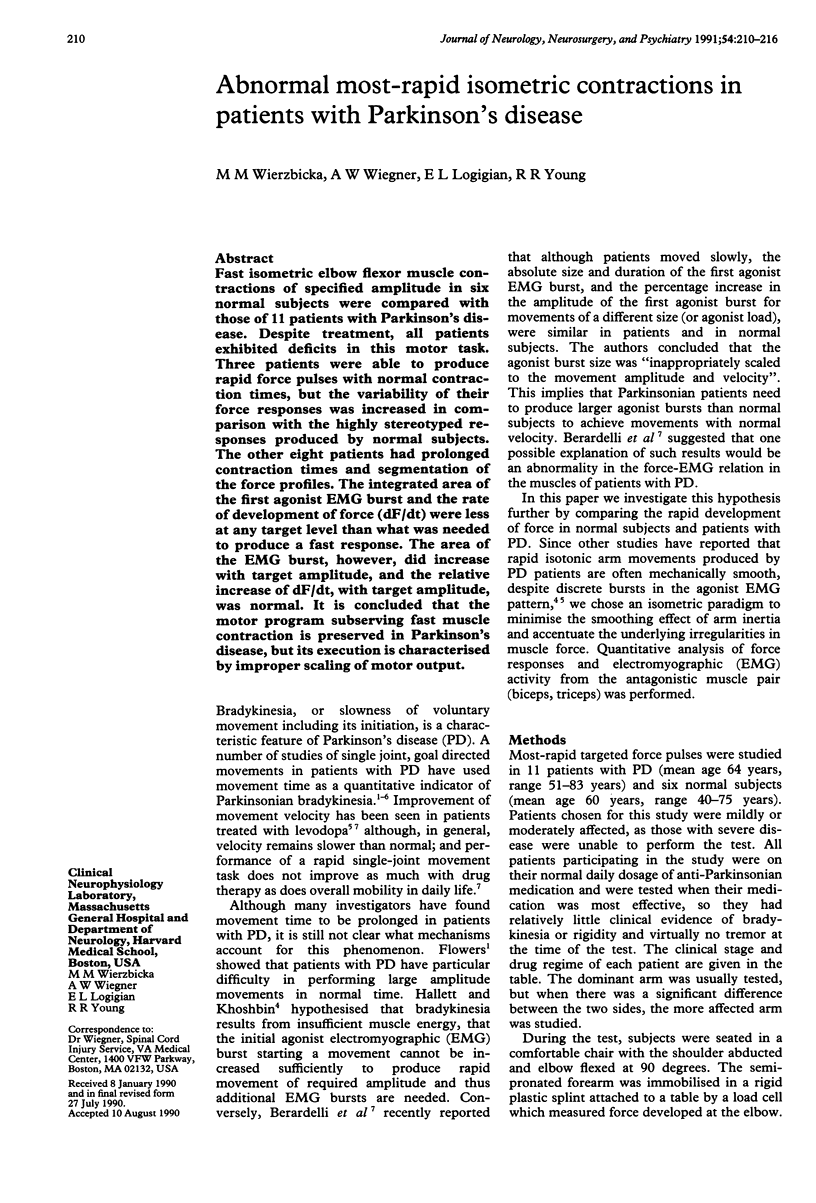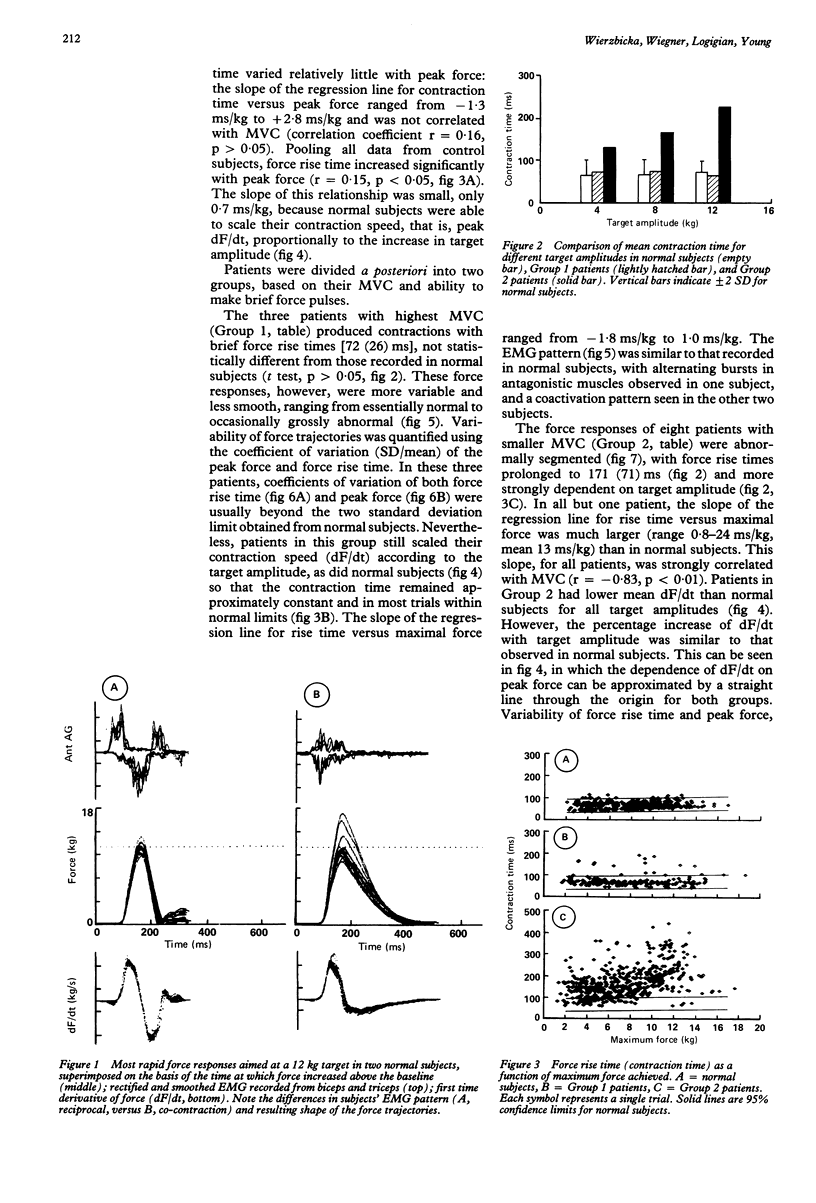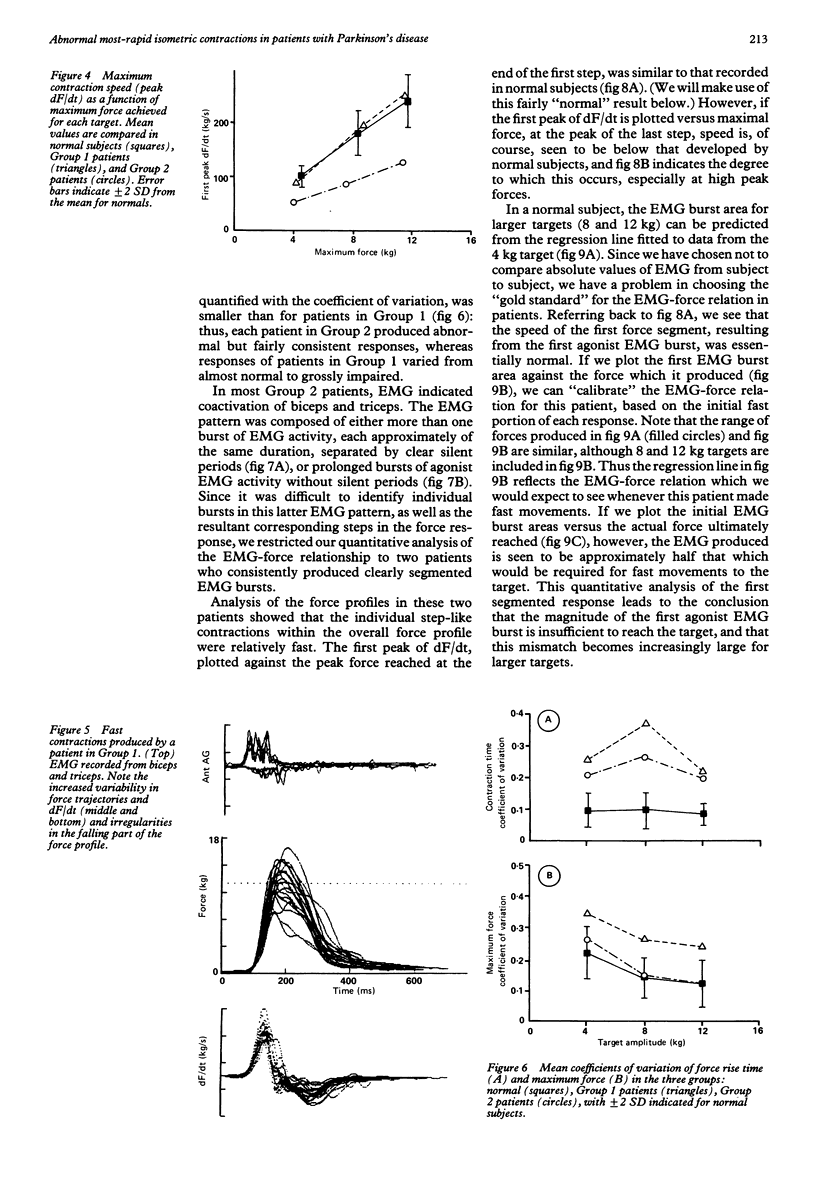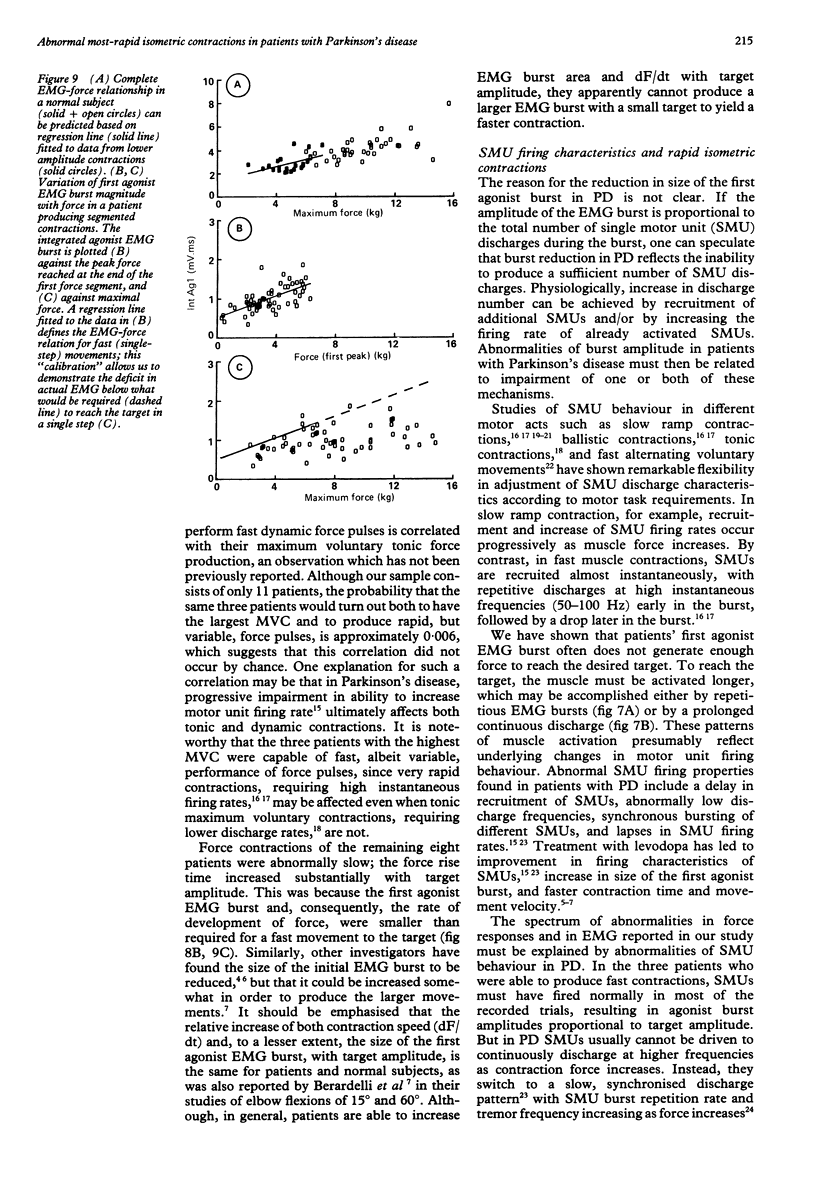Abstract
Fast isometric elbow flexor muscle contractions of specified amplitude in six normal subjects were compared with those of 11 patients with Parkinson's disease. Despite treatment, all patients exhibited deficits in this motor task. Three patients were able to produce rapid force pulses with normal contraction times, but the variability of their force responses was increased in comparison with the highly stereotyped responses produced by normal subjects. The other eight patients had prolonged contraction times and segmentation of the force profiles. The integrated area of the first agonist EMG burst and the rate of development of force (dF/dt) were less at any target level than what was needed to produce a fast response. The area of the EMG burst, however, did increase with target amplitude, and the relative increase of dF/dt, with target amplitude, was normal. It is concluded that the motor program subserving fast muscle contraction is preserved in Parkinson's disease, but its execution is characterised by improper scaling of motor output.
Full text
PDF






Selected References
These references are in PubMed. This may not be the complete list of references from this article.
- Baroni A., Benvenuti F., Fantini L., Pantaleo T., Urbani F. Human ballistic arm abduction movements: effects of L-dopa treatment in Parkinson's disease. Neurology. 1984 Jul;34(7):868–876. doi: 10.1212/wnl.34.7.868. [DOI] [PubMed] [Google Scholar]
- Bellemare F., Woods J. J., Johansson R., Bigland-Ritchie B. Motor-unit discharge rates in maximal voluntary contractions of three human muscles. J Neurophysiol. 1983 Dec;50(6):1380–1392. doi: 10.1152/jn.1983.50.6.1380. [DOI] [PubMed] [Google Scholar]
- Berardelli A., Dick J. P., Rothwell J. C., Day B. L., Marsden C. D. Scaling of the size of the first agonist EMG burst during rapid wrist movements in patients with Parkinson's disease. J Neurol Neurosurg Psychiatry. 1986 Nov;49(11):1273–1279. doi: 10.1136/jnnp.49.11.1273. [DOI] [PMC free article] [PubMed] [Google Scholar]
- Crawford P. M., West C. R., Chadwick D. W., Shaw M. D. Arteriovenous malformations of the brain: natural history in unoperated patients. J Neurol Neurosurg Psychiatry. 1986 Jan;49(1):1–10. doi: 10.1136/jnnp.49.1.1. [DOI] [PMC free article] [PubMed] [Google Scholar]
- Davis A. E., Wada J. A. Lateralisation of speech dominance by spectral analysis of evoked potentials. J Neurol Neurosurg Psychiatry. 1977 Jan;40(1):1–4. doi: 10.1136/jnnp.40.1.1. [DOI] [PMC free article] [PubMed] [Google Scholar]
- Desmedt J. E., Godaux E. Ballistic contractions in fast or slow human muscles: discharge patterns of single motor units. J Physiol. 1978 Dec;285:185–196. doi: 10.1113/jphysiol.1978.sp012566. [DOI] [PMC free article] [PubMed] [Google Scholar]
- Desmedt J. E., Godaux E. Ballistic contractions in man: characteristic recruitment pattern of single motor units of the tibialis anterior muscle. J Physiol. 1977 Jan;264(3):673–693. doi: 10.1113/jphysiol.1977.sp011689. [DOI] [PMC free article] [PubMed] [Google Scholar]
- Dick J. P., Rothwell J. C., Berardelli A., Thompson P. D., Gioux M., Benecke R., Day B. L., Marsden C. D. Associated postural adjustments in Parkinson's disease. J Neurol Neurosurg Psychiatry. 1986 Dec;49(12):1378–1385. doi: 10.1136/jnnp.49.12.1378. [DOI] [PMC free article] [PubMed] [Google Scholar]
- Dietz V., Hillesheimer W., Freund H. J. Correlation between tremor, voluntary contraction, and firing pattern of motor units in Parkinson's disease. J Neurol Neurosurg Psychiatry. 1974 Aug;37(8):927–937. doi: 10.1136/jnnp.37.8.927. [DOI] [PMC free article] [PubMed] [Google Scholar]
- Ferbert A., Rickert H. B., Biniek R., Brückmann H. Complex hyperkinesia during recovery from left temporoparietal cortical infarction. Mov Disord. 1990;5(1):78–82. doi: 10.1002/mds.870050118. [DOI] [PubMed] [Google Scholar]
- Flowers K. Ballistic and corrective movements on an aiming task. Intention tremor and parkinsonian movement disorders compared. Neurology. 1975 May;25(5):413–421. doi: 10.1212/wnl.25.5.413. [DOI] [PubMed] [Google Scholar]
- Freund H. J., Büdingen H. J., Dietz V. Activity of single motor units from human forearm muscles during voluntary isometric contractions. J Neurophysiol. 1975 Jul;38(4):933–946. doi: 10.1152/jn.1975.38.4.933. [DOI] [PubMed] [Google Scholar]
- Freund H. J., Büdingen H. J. The relationship between speed and amplitude of the fastest voluntary contractions of human arm muscles. Exp Brain Res. 1978 Jan 18;31(1):1–12. doi: 10.1007/BF00235800. [DOI] [PubMed] [Google Scholar]
- Ghez C., Gordon J. Trajectory control in targeted force impulses. I. Role of opposing muscles. Exp Brain Res. 1987;67(2):225–240. doi: 10.1007/BF00248545. [DOI] [PubMed] [Google Scholar]
- Gordon J., Ghez C. EMG patterns in antagonist muscles during isometric contraction in man: relations to response dynamics. Exp Brain Res. 1984;55(1):167–171. doi: 10.1007/BF00240511. [DOI] [PubMed] [Google Scholar]
- Gordon J., Ghez C. Trajectory control in targeted force impulses. II. Pulse height control. Exp Brain Res. 1987;67(2):241–252. doi: 10.1007/BF00248546. [DOI] [PubMed] [Google Scholar]
- Hallett M., Khoshbin S. A physiological mechanism of bradykinesia. Brain. 1980 Jun;103(2):301–314. doi: 10.1093/brain/103.2.301. [DOI] [PubMed] [Google Scholar]
- Hefter H., Hömberg V., Lange H. W., Freund H. J. Impairment of rapid movement in Huntington's disease. Brain. 1987 Jun;110(Pt 3):585–612. doi: 10.1093/brain/110.3.585. [DOI] [PubMed] [Google Scholar]
- Logigian E. L., Wierzbicka M. M., Bruyninckx F., Wiegner A. W., Shahahi B. T., Young R. R. Motor unit synchronization in physiologic, enhanced physiologic, and voluntary tremor in man. Ann Neurol. 1988 Mar;23(3):242–250. doi: 10.1002/ana.410230306. [DOI] [PubMed] [Google Scholar]
- Milner-Brown H. S., Fisher M. A., Weiner W. J. Electrical properties of motor units in Parkinsonism and a possible relationship with bradykinesia. J Neurol Neurosurg Psychiatry. 1979 Jan;42(1):35–41. doi: 10.1136/jnnp.42.1.35. [DOI] [PMC free article] [PubMed] [Google Scholar]
- Milner-Brown H. S., Stein R. B., Yemm R. Changes in firing rate of human motor units during linearly changing voluntary contractions. J Physiol. 1973 Apr;230(2):371–390. doi: 10.1113/jphysiol.1973.sp010193. [DOI] [PMC free article] [PubMed] [Google Scholar]
- Milner-Brown H. S., Stein R. B., Yemm R. The orderly recruitment of human motor units during voluntary isometric contractions. J Physiol. 1973 Apr;230(2):359–370. doi: 10.1113/jphysiol.1973.sp010192. [DOI] [PMC free article] [PubMed] [Google Scholar]
- Petajan J. H., Jarcho L. W. Motor unit control in Parkinson's disease and the influence of levodopa. Neurology. 1975 Sep;25(9):866–869. doi: 10.1212/wnl.25.9.866. [DOI] [PubMed] [Google Scholar]
- Wierzbicka M. M., Wiegner A. W., Shahani B. T. Role of agonist and antagonist muscles in fast arm movements in man. Exp Brain Res. 1986;63(2):331–340. doi: 10.1007/BF00236850. [DOI] [PubMed] [Google Scholar]
- Wiesendanger M., Rüegg D. G. Electromyographic assessment of central motor disorders. Muscle Nerve. 1978 Sep-Oct;1(5):407–412. doi: 10.1002/mus.880010512. [DOI] [PubMed] [Google Scholar]


